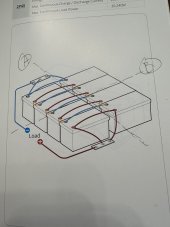TurbineTester
New Member
- Joined
- Apr 1, 2021
- Messages
- 143
As the title suggests i'm assembling a 48v system for my Motorhome. I have 8 12v 200Ah Ampere Time Batteries with 100A BMS. To help with space in the bays of the RV, I’m putting 4 batteries on the passenger side bay and 4 on a drivers side bay. I had been thinking of 4 batteries in series (4s) on the left and 4s on the right, and then putting the two sides in parallel (2p). This would give me 48v 400Ah. There is a picture in the manual of how to do this, but the picture has the two 4s strings right next to each other and every negative and positive battery post is connected across the two strings. See the diagram. My two bays are separated by about 3-4 feet. So that would be quite a lot of wire going across the bays (presumably to help aid in balance the batteries). It also seems like the diagram is a little excessive in the use of cables across the like polarity terminals. This would be physically splitting the system at dashed line A. The other thing I thought of is to make two 24v banks, one on each side of the RV, and those two 24V banks in series. This would be like physically splitting the system on dashed line B. This would be much simpler as only two wires would be needed to go across the gap between the bays. Again because of space, in each bay I’m planning on stacking the batteries 2x2, kind of making battery cube. That way I can use a bus bar to connect a + and - post across that short distance instead of making a tiny cable. So at this point I’m kind of leaning towards a 24v bank on each side.
I will use a 48V Inverter/Mppt controller (thinking the 3000w Growatt at this point) to charge the bank from Solar and to power my high amp items like microwave and one of my AC units, and also have a 48v/12v DCDC converter to allow the 48v bank to maintain the 2x12v BattleBorn Batteries I have for my 12v house system.
So my questions are:
Which layout is best? 2x24v banks or 2x48V banks?
What is the best readily available material at Lowes/HD/Amazon should I use to cut/drill the short bus connections?
I see T fuses mentioned a good bit in the forum when discussing series/parallel banks. Where might I need them?
What other questions should I be asking at this point?
Thanks
I will use a 48V Inverter/Mppt controller (thinking the 3000w Growatt at this point) to charge the bank from Solar and to power my high amp items like microwave and one of my AC units, and also have a 48v/12v DCDC converter to allow the 48v bank to maintain the 2x12v BattleBorn Batteries I have for my 12v house system.
So my questions are:
Which layout is best? 2x24v banks or 2x48V banks?
What is the best readily available material at Lowes/HD/Amazon should I use to cut/drill the short bus connections?
I see T fuses mentioned a good bit in the forum when discussing series/parallel banks. Where might I need them?
What other questions should I be asking at this point?
Thanks




